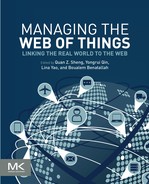Table of Contents
Part 1: Modeling and Searching
Chapter 1: Ontologies and context modeling for the Web of Things
1.2. Taxonomy and Comparison Framework
Chapter 2: The Anatomy of An Intent Based Search and Crawler Engine for the Web of Things
2.6. ThingSeek in Application: Flight Delay Analysis
Chapter 3: Modeling RESTful Web of Things Services
3.3. State of the Art in Mashup Tools
3.4. Model-Driven Engineering for WoT
3.5. Comparing Mashup and Model-Driven Engineering Approaches
3.6. Modeling of RESTful Services
3.7. Modeling WoT Systems with Generic RESTful Operations
Chapter 4: A Semantic-Rich Approach to IoT Using the Generalized World Entities Paradigm
4.2. State of the Art on Conceptual/Semantic IoT/WoT
4.4. An Architecture for the GWE Paradigm
Part 2: System Building and Practices
Chapter 5: Building a Web of Things with Avatars
5.3. Avatars and Avatar-Based WoT Platforms
5.4. Disruption-Tolerant Communications
5.5. Context Modeling and Management
5.6. A Social Vision of the Web of Things
Chapter 6: A WoT Testbed for Research and Course Projects
6.1. What you need to get started
6.3. WoT Features and Challenges
6.4. A Brief Survey of IoT and WoT Testbeds
6.5. Hardware and Software Components of a WoT Testbed
6.7. Project: Building a Testbed for the WoT
Chapter 7: Using Reference Architectures for Design and Evaluation of Web of Things Systems
7.2. Architecture Design Considerations for Web of Things Systems
7.3. A Case Study on Application of the Approach in Smart Homes Domain
7.5. Conclusions and Lessons Learned
Chapter 8: Efficient and Secure Pull Requests for Emergency Cases Using a Mobile Access Framework
Part 3: Data Integration and Analytics
Chapter 9: Automatic Integration and Querying of Semantic Rich Heterogeneous Data
9.2. Building the Semantic Web of Things (SWoT)
9.3. Semantic Web as Enabler of SWoT
9.4. Case Studies: Smart Applications
Chapter 10: Building Entity Graphs for the Web of Things Management
10.4. Applicability of DisCor-T: Things Classification
10.5. Applicability of DisCor-T: Things Recommendation
Chapter 11: Building Interoperable and Cross-Domain Semantic Web of Things Applications
11.1. Introduction: Understanding Trends and the Evolution
11.2. Related Work and Challenges Identification
11.3. Contributions and M3 framework
Chapter 12: Web of Things Data Storage
12.2. The Framework of WoT Data Storage
12.3. Methods and Challenge of WoT Data Storage
12.4. WoT Data Storage in Cloud Platform
Part 4: Applications, Security and Social Impact
Chapter 13: WoX: Model-Driven Development of Web of Things Applications
13.3. Open Issues and Challenges
13.4. The Web of Topics (WoX) Model
13.5. Design and Implementation
13.7. Conclusions and Future Work
Chapter 14: Security Issues of the Web of Things
14.1. Introduction: From IoT to WoT
14.2. The Existing Security Models
14.3. Security in the Web of Things
Chapter 15: A Web of Fitness “Things”: An Exploration of Social Impacts & Vulnerable Populations
15.1. Web of Things and Health: An Introduction
15.2. Potential Positive Implications for Health
15.3. Potential Challenges and Unintended Consequences for Social Health
